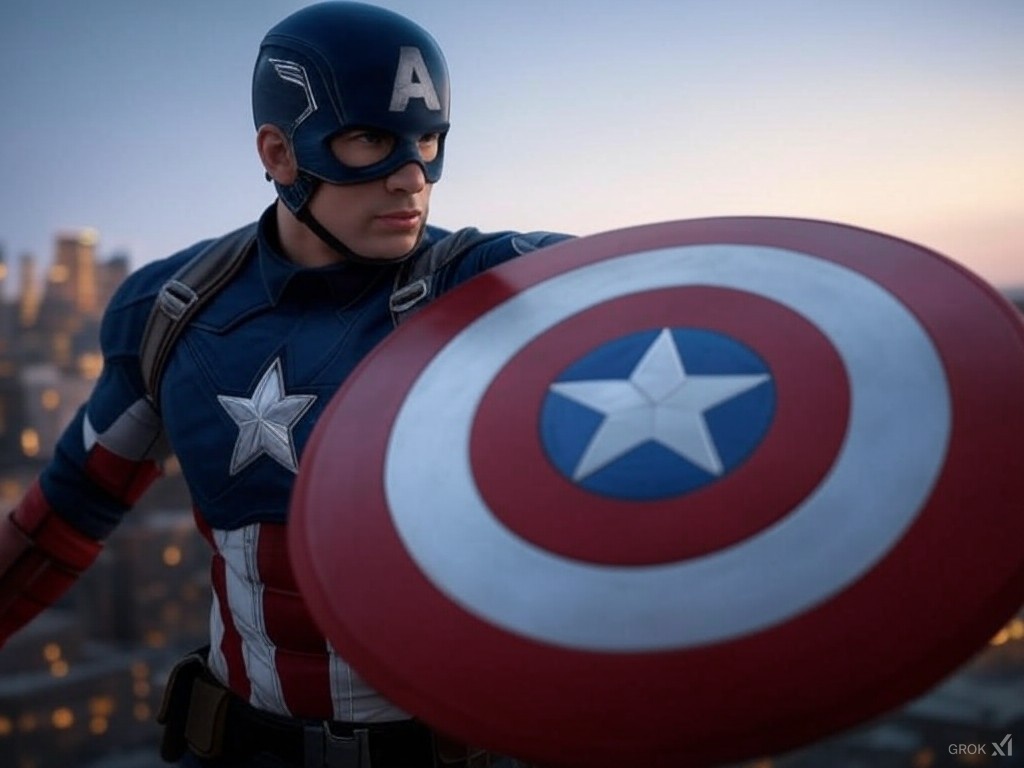
“Captain America” for several reasons
Patriotism: Steve Rogers was chosen to be the recipient of the Super-Soldier Serum during World War II as part of a government project to create the ultimate soldier.
His transformation into Captain America was meant to symbolize the strength and valor of the United States. His costume, adorned with the colors of the American flag (red, white, and blue), further emphasizes this patriotic theme.
Leadership and Morality: The name “Captain” implies leadership, which reflects Rogers’ role not only as a fighter but as a leader, both on and off the battlefield. He’s often portrayed as the moral compass of the Marvel Universe, embodying ideals like justice, duty, and honor, which are central to the American ethos as portrayed in comic narratives.
Historical Context: During the time the character was created (1941 by Joe Simon and Jack Kirby), America was entering World War II, and there was a strong nationalistic sentiment.
Captain America was explicitly designed to be a symbol of American might and resolve against the Axis powers, particularly Nazi Germany. The name “Captain America” was thus very fitting for a character meant to rally and inspire both in-universe and in the real world.
HISTORY OF CAPTAIN AMERICA
Creation and Early Years (1940s)
Creation: Captain America was created by Joe Simon and Jack Kirby and first appeared in “Captain America Comics” #1 in March 1941, published by Timely Comics (which would later become Marvel Comics).
Steve Rogers: The character behind the mask is Steve Rogers, a frail young man who was deemed unfit for military service during World War II.
He volunteers for an experimental program, the Super-Soldier project, where he is transformed into the peak of human perfection by the Super-Soldier Serum.
First Appearance: Captain America’s first comic cover famously showed him punching Adolf Hitler, symbolizing America’s entry into WWII.
Post-War Period
Fading Away: After WWII, with the decline in superhero comic popularity, Captain America was retired for a time. There were stories where he was lost in the Arctic ice, presumed dead.
The Silver Age Revival (1960s)
Revival: In “The Avengers” #4 (March 1964), Captain America was found in suspended animation in the Arctic by the Avengers. This marked his return to contemporary comics, where he joined the Avengers team.
Modern Challenges: Now out of his time, Steve Rogers faced a world of new challenges, including the Cold War, which reflected in his stories.
Evolution Through the Decades
1970s – 1980s: Captain America often dealt with political and social issues, including the Watergate scandal and rising tensions with the Soviet Union.
1990s: The character saw significant events like the “Heroes Reborn” where he was part of a new universe created by Rob Liefeld and Jim Lee, and later returned to the main Marvel Universe.
Modern Era
Civil War: One of the most significant arcs was “Civil War” (2006-2007), where Captain America was a key figure opposing the Superhuman Registration Act, leading to his apparent assassination by a sniper. This event was reversed later with Steve Rogers being out of time once again but eventually returning.
New Captain Americas: During periods when Steve Rogers couldn’t serve as Captain America, others like Bucky Barnes (Winter Soldier) and Sam Wilson (Falcon) have taken up the mantle, each bringing their own perspective to the character.
Recent Developments
Secret Empire: In 2017, Steve Rogers was revealed to be a Hydra agent due to a plot involving time-travel and cosmic cubes, though this was later addressed as a temporary anomaly.
Current Stories: Captain America continues to evolve, with stories focusing on legacy, leadership, and the American Dream in changing times.
Cultural Impact
Pop Culture: Captain America has transcended comics into movies, TV, and various forms of merchandise. His portrayal by Chris Evans in the Marvel Cinematic Universe (MCU) has significantly increased his global recognition.
Symbolism: Over the years, Captain America has become a symbol not just of patriotism but of moral integrity, leadership, and the fight for justice, often critiquing and questioning the very ideals he represents.
“We Are Comics”






